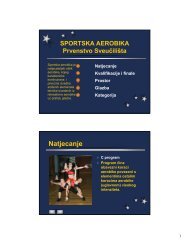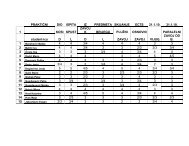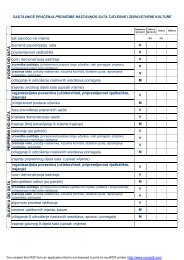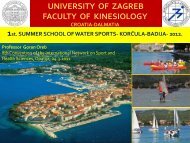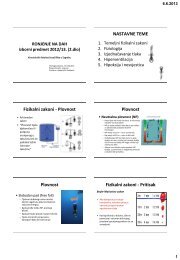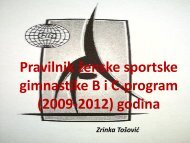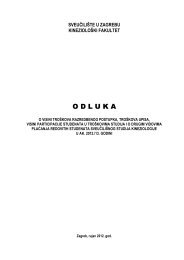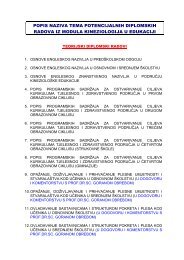Research Methodology of Kinesiology
Research Methodology of Kinesiology
Research Methodology of Kinesiology
Create successful ePaper yourself
Turn your PDF publications into a flip-book with our unique Google optimized e-Paper software.
No. Title <strong>of</strong> the subject: <strong>Research</strong> <strong>Methodology</strong> <strong>of</strong> <strong>Kinesiology</strong><br />
1. Module / Subject leader Full pr<strong>of</strong>essor Franjo Prot, PhD<br />
2. University teachers and instructors Full pr<strong>of</strong>essor Franjo Prot, PhD<br />
Assistant pr<strong>of</strong>essor Goran Sporiš, PhD<br />
3. Contact hours 60<br />
4. Contact hours – seminars and 30<br />
practical work<br />
5. Number <strong>of</strong> hours necessary for<br />
student individual work (seminar<br />
papers, essays, projects, etc.)<br />
15<br />
6. Number <strong>of</strong> hours necessary for<br />
student preparation for the<br />
examination<br />
7. Number <strong>of</strong> hours necessary for other<br />
forms <strong>of</strong> work (if planned)<br />
72<br />
15<br />
8. Total number <strong>of</strong> hours necessary for 162<br />
completion <strong>of</strong> the subject taught<br />
9. Illustrative contents Scientific foundation <strong>of</strong> researching sport, phyisical education and<br />
exercise science. Exercise and training as kinesiological transformational<br />
process. Diagnostic, prognostics and explanatory operations.<br />
Methodological fundamentals <strong>of</strong> research in kinesiology. Methodological<br />
principles and the purposefulness <strong>of</strong> research.<br />
Independence, interdisciplinarity, transdisciplinarity and the topic <strong>of</strong><br />
research in kinesiology. Education, qualification and organizational forms<br />
<strong>of</strong> work in domains <strong>of</strong> kinesiology.<br />
Types <strong>of</strong> research: fundamental and applied. Topics <strong>of</strong> scientific research<br />
and their position with regard to the structure <strong>of</strong> kinesiology, the<br />
relationship between kinesiology and other sciences. Methods <strong>of</strong><br />
research in kinesiology. Hypotheses generating methods. Data collection<br />
methods. Data analysis methods. Interpretation <strong>of</strong> results.<br />
Sampling criteria. Kinesiometric equivalents <strong>of</strong> kinesiological<br />
manifestations. The analysis <strong>of</strong> the latent structure <strong>of</strong> manifest variables<br />
in kinesiology and cognate disciplines. Correlational, regressional and<br />
canonical approach to the relations between the sets <strong>of</strong> variables.<br />
Identification <strong>of</strong> differences between typical groups <strong>of</strong> kinesiological<br />
subjects. Taxonomic approach to kinesiological phenomena. The analysis<br />
<strong>of</strong> quantitative changes. The analysis <strong>of</strong> qualitative changes.<br />
Reporting. Presentation and publication <strong>of</strong> research results (written, oral,<br />
multimedia). Structuring <strong>of</strong> scientific and pr<strong>of</strong>essional works. Individual<br />
and team work, authorship and patents.<br />
Types <strong>of</strong> graduation thesis. The procedure and the criteria for submission<br />
<strong>of</strong> requests for the endorsement <strong>of</strong> the topic <strong>of</strong> the graduation thesis.<br />
Elaboration and realization <strong>of</strong> the graduation thesis project submission.<br />
10. Learning outcomes (general and<br />
specific competences, knowledge<br />
and skills acquired)<br />
The students will get an insight into the possible approaches, the latest<br />
results and the appropriate research methodology that enables the<br />
understanding <strong>of</strong> results <strong>of</strong> scientific and pr<strong>of</strong>essional work in kinesiology.<br />
They will be able to choose the appropriate approach when selecting the<br />
area <strong>of</strong> research, the appropriate topics and the corresponding<br />
methodology <strong>of</strong> outlining simpler research studies in kinesiology.<br />
11. Learning and teaching methods Lectures and seminars.<br />
12. Other student duties (if planned) Participation at conferences and symposia.<br />
13. Evaluation <strong>of</strong> student academic<br />
progress, or type <strong>of</strong> the examination<br />
Oral examination. (The written examination is also possible.)<br />
14. Compulsory reading list 1. Thomas, J.R., Nelson J.K. and Silverman S. (2005). <strong>Research</strong> methods in<br />
physical activity. 5 th edition. Champaign IL: Human Kinetics Publishers, Inc.<br />
ISBN-13: 978-0736056205
2. Thomas, J.R., Nelson J.K. and Silverman S. (2010). <strong>Research</strong> methods in<br />
physical activity. 6 th edition. Champaign IL: Human Kinetics Publishers, Inc.<br />
ISBN-13: 978-0736056205<br />
3. Berg J.R., Latin R.W. (2004). Essentials <strong>of</strong> <strong>Research</strong> methods in Health,<br />
Physical education, Exercise Science and Recreation. activity. 3 rd edition.<br />
Lippincott Williams & Wilkins ISBN-13: 978-0781770361<br />
15. Optional reading list 1. Gratton, C. and I. Johnes, (2010). <strong>Research</strong> methods in sport studies. 2 nd<br />
edition. Abingdon UK: Routledge ISBN-13: 978-0415493932<br />
2. Sparks, A. C. (Ed.) (1992). <strong>Research</strong> in physical education and sport -<br />
Exploring alternative visions. The Elmer Press, London, Washington D.C.<br />
16. ECTS credit rating 5<br />
17. Explanation <strong>of</strong> the ECTS credit<br />
rating<br />
18. Assessment <strong>of</strong> teaching quality and<br />
effectiveness<br />
The number <strong>of</strong> ECTS credits equals the number <strong>of</strong> hours necessary to<br />
meet the demands <strong>of</strong> the subject taught and to prepare for the<br />
examination.<br />
Keeping the record <strong>of</strong> student efficiency in examination. Anonymous<br />
questionnaire filled in by the students.


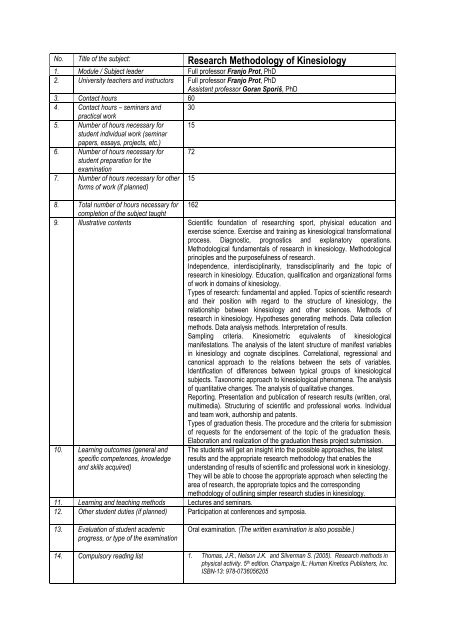
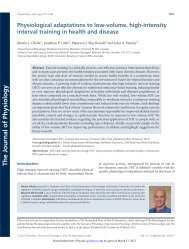

![NASTAVNI_PLAN_I_PROGRAM-_integrirani_studij [2,09 MiB]](https://img.yumpu.com/23830973/1/184x260/nastavni-plan-i-program-integrirani-studij-209-mib.jpg?quality=85)
